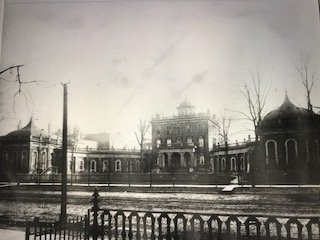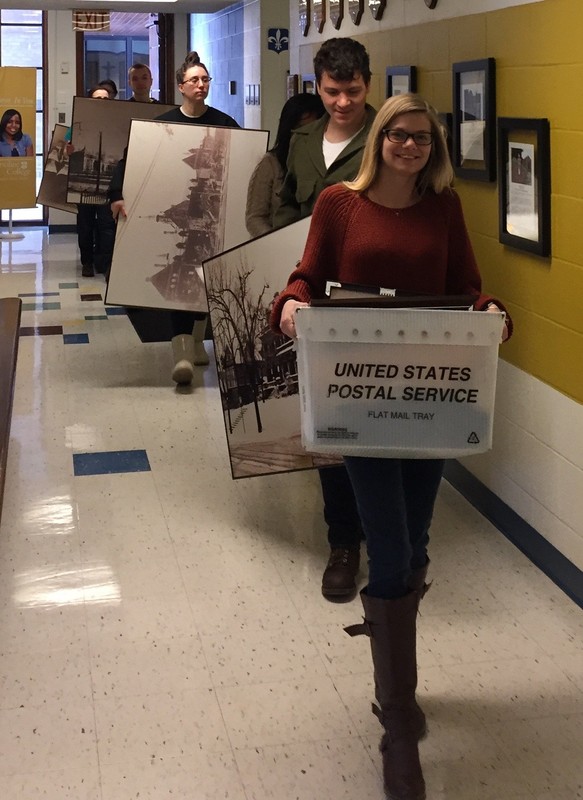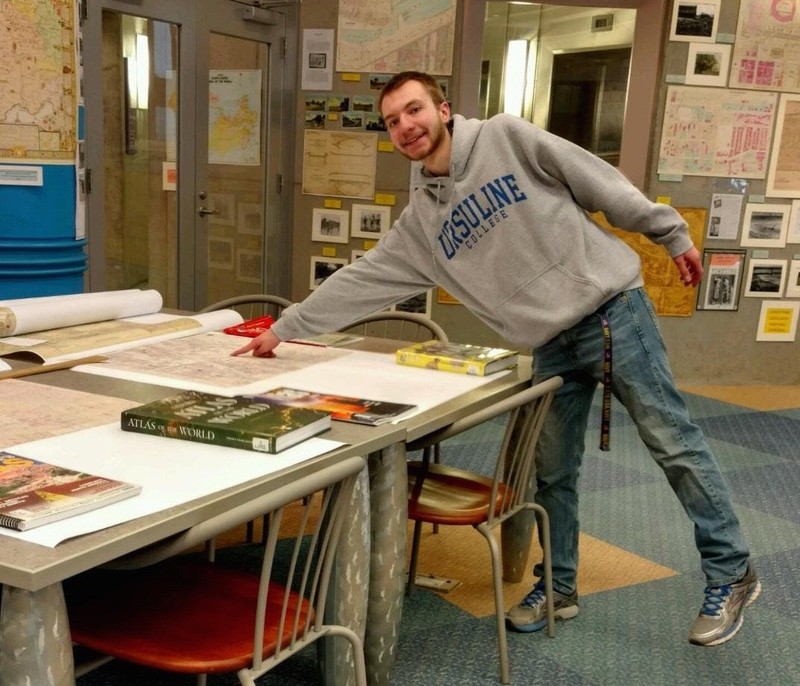Ursuline College 1871 First Campus
Introduction
Text-to-speech Audio
Images
Ursuline students attended this campus on Euclid Avenue near Cleveland's public square from 1871 until their 1892 move eastward to more spacious quarters.

Students from the Designing Ursuline exhibit team gather already framed photographic prints from various departments around Ursuline College for display at the anniversary exhibit in Wasmer Art Gallery, Ursuline College, Spring 2017.

Found it! Clay researches the various locations of our Ursuline College campuses using the map collection at our own Cleveland Public Library.

This 1870s sofa graced the formal rooms at Ursuline College's first campus.

Backstory and Context
Text-to-speech Audio
Although many of the buildings that originally housed Ursuline College no longer stand, following the journey of Cleveland’s Ursuline sisters’ educational endeavors from one campus to another tells a tale of Cleveland’s city growth, population movement, the changing needs of women’s education, and the Ursuline sister’s commitment to serving their community. The legacy of the Ursuline sisters educational endeavors lives on at the current campus of Ursuline College at 2550 Lander Road, Pepper Pike, Ohio.
1850 From across an ocean
“As a young priest in France, Father [Amadeus] Rappe had been the chaplain at the Ursuline Academy in Boulogne-sur-Mer…. He knew well the educational work of the Ursulines…. Bishop Rappe turned to his friends in France and begged them to open a school in Cleveland,” recorded Sister Anna Margaret Gilbride.1
Five Ursuline sisters answered the Bishop’s call to come to Cleveland, a burgeoning metropolis on the banks of Lake Erie. They were: Mary Beaumont, known as Mother Mary of the Annunciation; Sister Theresa Young des Seraphine; Sister Victoire Boudalier des St. Charles; Sister Sylia Picquet des St. Benoit; and Arabella Seymour, who became Sister Mary St. Austin.2
Settling into Cleveland
In preparation for welcoming the Ursuline sisters and their mission, Bishop Rappe purchased a high-style two-story brick house once owned by Judge Samuel Cowles and constructed by revered master builder Jonathan Goldsmith near the downtown on Euclid Avenue (then still a dirt road!).3
The Ursuline sisters arrived on August 8, 1850, and immediately set to work adapting the mansion to the needs of a convent and school. Full of energy and conviction, they advertised their opening of a school for girls on September 6, less than a month away. According to Dr. Patrick Riley, 300 girls arrived on the steps of the school that first day, convincing the community of resounding success.4
To ensure that the government would not be able to confiscate church property, as had frequently occurred in Europe, Mother Mary incorporated the Ursuline Academy of Cleveland in 1854, later including Ursuline College as one of the Academy’s division.5
17 November 1871, A bold request granted
As Dr. Patrick Riley later related, “Recognizing the need for higher education for Catholic women, Mother [Mary Beaumont] made a rather bold request of the State of Ohio and sought a charter to open a women’s college in Cleveland…. [On] November 17, 1871, Ursuline College became the first college for women in Ohio and among the very first Catholic colleges for women in the United States.” The college featured a liberal arts curriculum with classes housed in same building as the Academy.6
1871 First Campus, Ursuline College
The college’s popularity and success required expansion of the original two-story mansion to include a third story plus two long, curved, flanking wings. The building retained much of its Federal and Greek Revival style architectural elements. Both Federal style (popular ca. 1780-1840) and Greek Revival style (popular ca. 1830-1850) included very formal space with rooms for specialized purposes. The exteriors were known for their use of balance, symmetry, and restraint to emphasis civic virtues such as order, logic, and balance. Leaders of the young United States of America looked to the great Roman Republic for models of self-government and political systems. They also identified with the classical Greek ideals of democracy and individual civic responsibility, so looked to the most prominent of Greek buildings, the Parthenon, for inspiration. These were intentionally reflected in the architecture chosen for major governmental buildings in Washington, D.C., and became popular for residential architecture as well.
Cleveland success story
The popularity and necessity of women’s education increased dramatically in the late 19th century. “By the 1880s twice as many women [as men] were graduating from Cleveland high schools…. While men often left home to attend college, women tended to remain close. Increasingly women sought higher education, challenging old institutional models, but they still had few options in college education,” as noted by Ursuline College in Educational and Architectural Perspective.7
Looking eastward
As the city center became increasingly crowded and their student body grew, the Ursuline sisters turned their attention to the growing population in the eastern sections of Cleveland and planned for a larger facility to house Ursuline College, Academy and the Motherhouse. Their attention was captured by property available at the intersection of Scovill Avenue and Wilson Street (now East 55th).
Sources
1Sister Anna Margaret Gilbride, “Ursuline College: Leader in the Education of Women,” in Cradles of Conscience: Ohio’s Independent Colleges and Universities, ed. John William Oliver, Jr., James A. Hodges, and James H. O’Donnell (Kent: Kent State University, 2003), p. 463.
2Gilbride, “Ursuline College,”464.
3Gilbride, “Ursuline College,”464.
4Patrick Riley, Wall text. Designing Ursuline. (Pepper Pike, Ohio: Wasmer Art Gallery, Ursuline College, 2017.
5Gilbride, “Ursuline College,” 464.
6Riley, 2017.
7Beam, Jessica, et al, “Ursuline College in Educational and Architectural Perspective,” Slideshow. (Ursuline College Student Research Symposium, 2016).
Bibliography:
Beam, Jessica, Karl Brunjes, Tara Smith Carlson, Ashley Hardison Herhuth, and Gail Peabody. “Ursuline College in Educational and Architectural Perspective.” Slideshow. Ursuline College Student Research Symposium. 2016.
Gilbride, Sister Anna Margaret. “Ursuline College: Leader in the Education of Women.” In Cradles of Conscience: Ohio’s Independent Colleges and Universities, edited by John William Oliver, Jr., James A. Hodges, and James H. O’Donnell, 463-465. Kent: Kent State University, 2003.
Riley, Patrick. Wall text. Designing Ursuline. Wasmer Art Gallery. Ursuline College. Pepper Pike, Ohio. 2017.
Repositories:
Archives, Besse Library, Ursuline College, 2550 Lander Road, Pepper Pike, Ohio 44124
Archives, Ursuline Sisters of Cleveland, 2600 Lander Road, Pepper Pike, Ohio 44124
